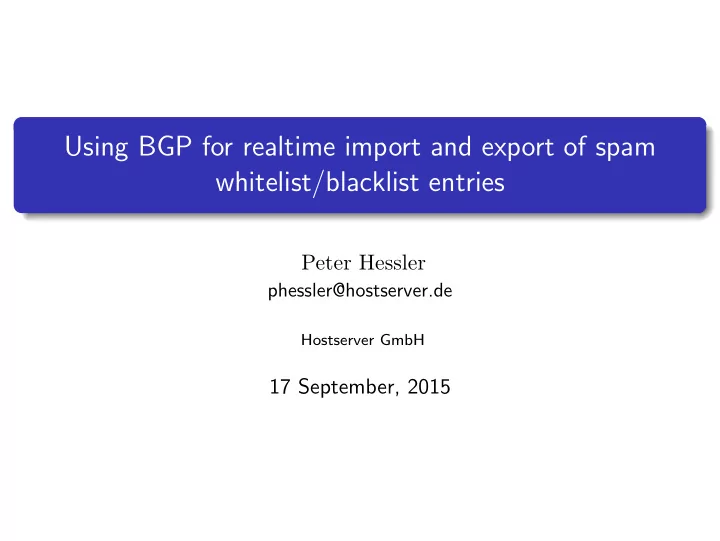

Using BGP for realtime import and export of spam whitelist/blacklist entries Peter Hessler phessler@hostserver.de Hostserver GmbH 17 September, 2015
traditional methods network-based spam fighting: download a file from a server every $periodic live lookups from an external provider (e.g. DNS lookups)
traditional methods some obvious problems with both methods only as fresh when you downloaded the file ...the provider may only generate the file on their own schedule ...leading to most-pessimistic schedules massive load and congestion at the top of the hour “network bogons” problem ability to receive mail is limited by the external service response speed behavior when the service is not available (e.g. Spamhaus ddos)
bgp-spamd.net network-based spam fighting: bypass and trap lists from spamd(8) use BGP-4 and BGP communities (RFC 4271 & RFC 1997) for distribution and labeling
bgp-spamd.net only list the specific IP addresses that exhibited a specific behaviour do NOT penalize/reward network neighbors really simplistic, we just want to catch the low-hanging-fruit don’t open your mail server to the world don’t block the world from seeing your mail server greylisting is powerful, when it still applies!
why is this useful use the bypass and trap lists from 3rd parties ...they are much larger than you (and/or) ...they have different traffic patterns than you ...semi-trusted servers are usually semi-trusted elsewhere ...ditto for attackers shared bypass lists help the “gmail sender” problem
bgp-spamd.net available at http://www.bgp-spamd.net all configurations and scripts are available I am interested in additional “spamd-source” servers, please contact me and of course, more users are always welcome
bgp-spamd.net Publically launched at AsiaBSDCon 2013 on March 17 3 upstream sources 4 users
bgp-spamd.net A year later (16 May 2014) 5 upstream sources 28 users
bgp-spamd.net 6 months ago (14 March 2015) 5 upstream sources 55 users 2 route servers
bgp-spamd.net Today (12 September 2015) 5 upstream sources 134 users 2 route servers
spamd-source trap list using greylisting generated from source server’s spamd trap list addresses are listed if their first delivery attempt is to a spamtrap expires in 24 hours from last delivery attempt
spamd-source bypass list spamd has a very low bar to be added to the whitelist ...redelivery within 4 hours ...kept in the whitelist for 36 days. semi-trusted email server list used to bypass spamd higher entry bar than normal spamd whitelist in the whitelist for 75 days, and sent more than 10 emails ...we “think” it’s a real mail server again, do not be overly aggressive
results SUCCESS
lessons learned overall, a success generally positive reactions from users
the good many sources sharing information block lists are supurb
the good 3rd parties are making this work with non-OpenBSD users! Mark Martinec made it work with FreeBSD, rbldnsd, and SpamAssassin Anonymous using Quagga and their Propritary infrastructure (thank you!)
the good very fast to update 7 seconds to download the full bypass and trap lists over crappy home dsl 2 seconds to propagate changes to all members ... can be even faster, needs more work
the bad bypass list has too many spammers on it ... several users have mentioned they had to stop using it ... we need to spend more time adjusting the heuristics
the bad server crash, causing 5 day outage ...while I was on vacation (in New Zealand) ...and during long holiday weekend in the US ...where the only route server was
the ugly I have not been as responsive as I should have been have not had a lot of time to dedicate to improving ... code ... sources ... client usage
future work fix the heuristics for addition to the bypass list ... a bit *too* relaxed the “gmail sender” problem is *worse* with IPv6! ... a single email can use many hundreds of IPs within the same /64
future work - spamd-source easier processing of spamd(8) on spamd-source systems can spamd differentiate how it received the data more spamd-sources from different and new countries ... University students in CA do not send a lot of email to JP
future work - brainstorming voting ... “two upstreams think an IP is X, then make it X” ... somewhat tricky, as BGP doesn’t support this (ab)using an RPKI lookup process to process addresses before adding ... pretend to do RPKI ... do stuff ... allow or disallow address from being listed ... for now, only thoughts with no code
Acknowledgements Many thanks to my coauthor Bob Beck, the University of Alberta at ualberta.ca Bob Beck of obtuse.com , Henning Brauer of bsws.de Peter N.M. Hansteen of BSDly.net , for being sources of spamdb information. Sonic for hosting the California USA implementation us.bgp-spamd.net and Hostserver GmbH for sponsoring the Frankfurt Germany implementation eu.bgp-spamd.net
Questions?
Recommend
More recommend